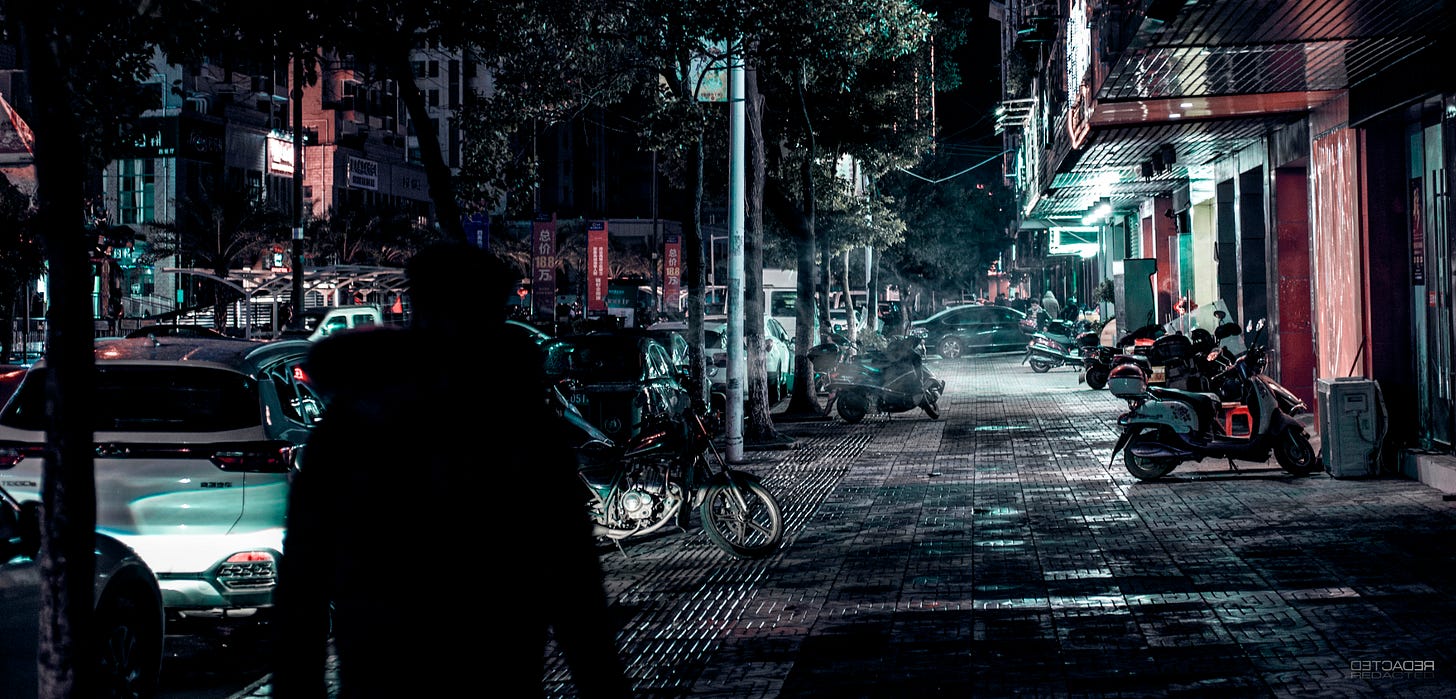Active ‘Street Assessment’ CIA Method
How Spies Actively Assess The Urban Environment They're Currently In.
It’s high-speed, low-drag situational awareness done on the move. It’s how operatives turn chaotic urban sprawl into readable intel while staying two steps ahead of surveillance or contact.
Every corner, every crowd, every subtle shift in rhythm is either a threat or an opportunity. This isn’t just walking through a city, it’s dissecting it in real time using hardwired tradecraft, gut instinct, and a tactical eye. You’re not just in the environment, you own it, silently and surgically.
It’s not just “looking around.” It’s about reading the environment like it’s a live feed of data, while staying in motion. Operatives don’t get to stop and analyze a scene like in a lab - you do it on the move while blending in.
First is [Baseline Establishment]
You do this as soon as your boots hit a new block. You’re “sightseeing” by clocking the pulse of the street. The moment you enter a neighborhood, start building that mental snapshot. What’s considered normal here? You need to blend in while collecting data fast. Stay subtle. Don’t fixate.
Your peripheral vision does most of the heavy lifting. You’re not reacting yet, you’re recording. This is the foundation that lets you detect shifts and threats before they fully form.
What you’re scanning, and you better process it in real time:
Pace of Movement - Are people strolling, rushing, loitering? Fast or slow, uniform or mixed? Any sudden differences in movement might signal watchers or staging.
Clothing Norms - What’s the local dress code? Are suits out of place? Hoodies normal? Anyone dressed too tactical, too bland, or too flashy for the area?
Street Vendor Patterns - Who’s posted up and where? Are vendors busy, social, or on edge? A vendor out of sync with the local rhythm might be cover.
Law Enforcement or Security Presence - Uniformed patrols? Private guards? Cameras? Drones? How visible are they and what routes do they follow?
Traffic Flow and Noise - Is there consistent honking, sirens, foot traffic? Is it unusually quiet for the time of day? Sound anomalies are just as loud as visual ones.
Local Interactions - Are people chatty? Closed off? Eye contact common or avoided? Look at social behavior, it’s a cultural fingerprint.
Territorial Markers - Tags, flags, turf signs, or color codes? These can indicate gang presence, political alignment, or ethnic divides.
You soak all that in fast, because you’ll be comparing everything that follows against it. Anything that doesn’t fit (too still, too fast, too clean, too quiet) pings the radar. Every city’s got a rhythm, and when it skips a beat, you better hear it. This is tradecraft 101, you can’t spot a tail or a setup if you don’t know what normal looks like first.
Next, [Threat Detection through Movement Analysis]
Once you’ve locked in the baseline, it’s time to start dissecting movement - not yours, theirs. While watching people, you’re assessing how they move. This is about patterns, timing, and subtle synchronicity.
Anyone can look harmless, but movement doesn’t lie. If someone’s trailing you across multiple blocks, matching pace through two or three turns, or popping up too often, you’ve got a problem. Tails don’t always wear sunglasses and trench coats. Most of the time, they look like tourists or locals. Tradecraft means spotting the behavior, not the costume.
Start running this checklist through your mental filter as you move:
Pace Matching - Is someone maintaining your speed block after block, even through shifts in crowd density or stop-and-go flow?
Route Duplication - Has a person or vehicle taken the same strange turns you have, especially through non-obvious routes?
Micro-Adjustments - Do they change their body angle, pause at the same time as you, or mirror your position relative to obstacles or intersections?
Delay Behavior - Does someone stop to tie their shoe, check their phone, or pretend to browse just when you pause? That’s not casual.
Transport Tails - Has the same car appeared twice on different streets? Are windows up too high, license plates dirty, or interior silhouettes stiff?
Over-attention vs. Under-attention - Are they avoiding eye contact too much or giving just enough to suggest feigned disinterest?
Group Dynamics - Do individuals keep reappearing in different clusters? Are “couples” not interacting like real ones would?
You’re not chasing ghosts here, you’re observing behavior repetition. Once is random, twice is coincidence, three times is surveillance. Your gut will flare first, but you confirm with data. That’s how seasoned operatives operate. You don’t confront, you assess and maneuver - keeping your posture neutral while mentally flagging and stacking the threat profile. Trust movement. It always betrays intent.
Next, [Strategic Movement and Route Scanning]
Keep reading with a 7-day free trial
Subscribe to The Tradecraft Guide to keep reading this post and get 7 days of free access to the full post archives.







